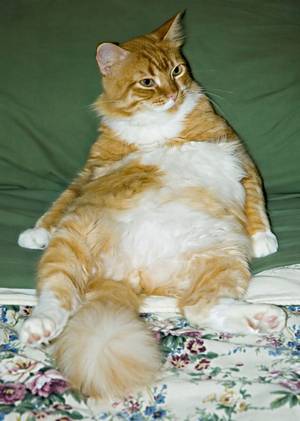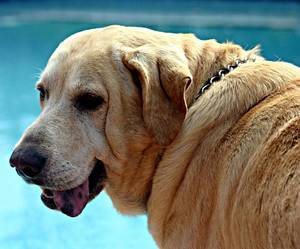Dog Obesity And Fat Cats

Obesity is a growing problem for domestic pets. Both dogs and cats are considered obese when they weigh more than 15% over their ideal bodyweight.
Worldwide, the between 20 and 40% of pets are estimated to be obesity. An Australian study in 2005 found that over 33% of dogs were classed as overweight, with another 7% classified obese.
With the increasing trend of pet owners living in apartments, more pets are being kept indoors and getting less exercise, thus not burning off all of the calories they are consuming. This problem is only going to get bigger (pun intended).
Indoor living is only one contributing factor to pet obesity. A poor diet, overfeeding,(particularly treats and human foods), a lack of exercise, ageing, desexing, certain medical conditions and genetic predispositions have also been linked to an increased likelihood of overweight pets.
Certain breeds of dog are more likely to be overweight. Not surprisingly, the Labrador Retriever heads this list, but Cavalier King Charles Spaniels, Cocker Spaniels, Collies, Basset Hounds, Cairn and Scottish Terriers, Beagles and Dachshunds are also over-represented.
Of our feline friends, domestic shorthairs are the most common breed with a weight problem. Diseases such as Hypothyroidism (an underactive thyroid gland), hyperadrenocorticism (Cushing's disease) or hypoadrenocorticism (Addison's disease) are also associated with obesity. Medications such as corticosteroids (often prescribed for allergies and the like) have an unfortunate side effect of increasing the appetite, often resulting in obesity.
|
"Overweight animals have a greater risk of a number of health problems. These include osteoarthritis,
diabetes
mellitus, heart and lung disease, urinary tract disease, skin disease and certain types of cancer."
|
So Rover is a little pudgy... what's the big deal? Like their overweight human counterparts, overweight animals have a greater risk of a number of health problems. These include osteoarthritis, diabetes mellitus, heart and lung disease, urinary tract disease, skin disease and certain types of cancer. They also have a shorter life expectancy and a reduction in general wellbeing.
How can you tell if your pet is overweight? A system called "body condition scoring" is commonly used to evaluate your pet's weight. A pet at its ideal weight will have ribs just visible (in short-coated breeds) and palpable, a definite waist behind the ribs and a slight tuck up of the abdomen. A pear-shaped pet is not an ideal weight! Your veterinarian can advise you an appropriate goal weight for your pet, based on breed, sex and other factors.
To help obese pets lose weight, we need to reduce their daily calorie intake below their daily calorie expenditure, so that the excess requirement will come from fat deposits being used up. The most comon ways of achieving this include decreasing the number of calories fed to the animal and increasing its exercise level (and therefore the number of calories used).
|
Pet food additives
|
| Pet Shed's most popular vitamin and mineral supplements for your dog or cat's diet: |
Vets normally aim for pets to lose 1-3% of bodyweight per week. It is important for the pet's progress to be monitored weekly, with weigh-ins and a check of their condition score. If the pet is not losing weight at the appropriate rate, the program for the pet can be reassessed as required, with feeding or exercise level modifications.
To reduce the calorie intake, the amount fed each day can be reduced or special low-calorie foods can be used. Most vets will recommend the latter option, as the original diet contributed to the problem in the first place. Also, regular maintenance diets deliver a balanced amount of vitamins and minerals on the basis of the dog consuming a particular level of calories per day. When on a reduced calorie diet, there is a risk that the pet may not receive sufficient vitamins or minerals and become malnourished.
Commercial low-calorie foods are designed to ensure that the pet feels full and receives the correct quantities of vitamins and minerals, but with a lower energy content. These tend to be higher in fiber or in protein and lower in fat. One member of the family should be responsible for feeding your pet twice per day (not ad lib) to avoid it being fed several times...those puppy dog eyes can be irresistable!. Also, stop feeding your pet table scraps and other treats, which are often very high in fat. Again, all members of the family (and friendly neighbors) must obey this rule!
 Some owners prefer to serve their pet a homemade diet,
and your vet will be able to advise an appropriate recipe - perhaps incorporating extra fiber (such as more
vegetables) so your pet feels physically full but has consumed a lower number of calories.
Some owners prefer to serve their pet a homemade diet,
and your vet will be able to advise an appropriate recipe - perhaps incorporating extra fiber (such as more
vegetables) so your pet feels physically full but has consumed a lower number of calories.
In Australia, a dietary supplement has recently been released onto the market called Vet-a-Slim. This product contains vitamins and minerals and proteins from the white kidney bean seed, to help regulate the level of calories and carbohydrates absorbed by the body. This, in conjunction with a reduced calorie diet and a regular exercise plan, is reported to be effective in inducing weight loss in overweight animals. This product is available without prescription, but should be used in conjunction with veterinary advice.
In dogs, increasing their exercise level can be as easy as regular leash walking (once or twice a day everyday), swimming, running your pet on a treadmill or playing fetch with toys. With older pets take care with high-impact running and jumping. They often have a degree of arthritis and can pull up very sore after too rigorous an exercise session.
It is more difficult to exercise cats. Toys can be effective with some animals, particularly those with catnip in them. Hiding food in places about the house or garden or not serving it all in a bowl can encourage both cats and dogs to work a little harder for their food. Again your vet will be able to recommend the most appropriate exercise plan for your pet and you, based on your lifestyle, location and time available. This exercise will not only help your pet maintain a healthy weight, but will also be good for your own wellbeing.
|
References
|
| 1. Maintaining a Healthy Weight; Body Condition System. Purina Pet Care.
http://www.Purina.com 2. Vet-A-Slim product information. Nature Vet Australia. http://www.vetaslim.com.au 3. German, A. The Growing Problem of Obesity in Dogs and Cats. Proceedings 2006 WSAVA World Conference 4. Elliott, D. Nutritional Management of Canine Obesity. Proceedings 2006 WSAVA World Conference |